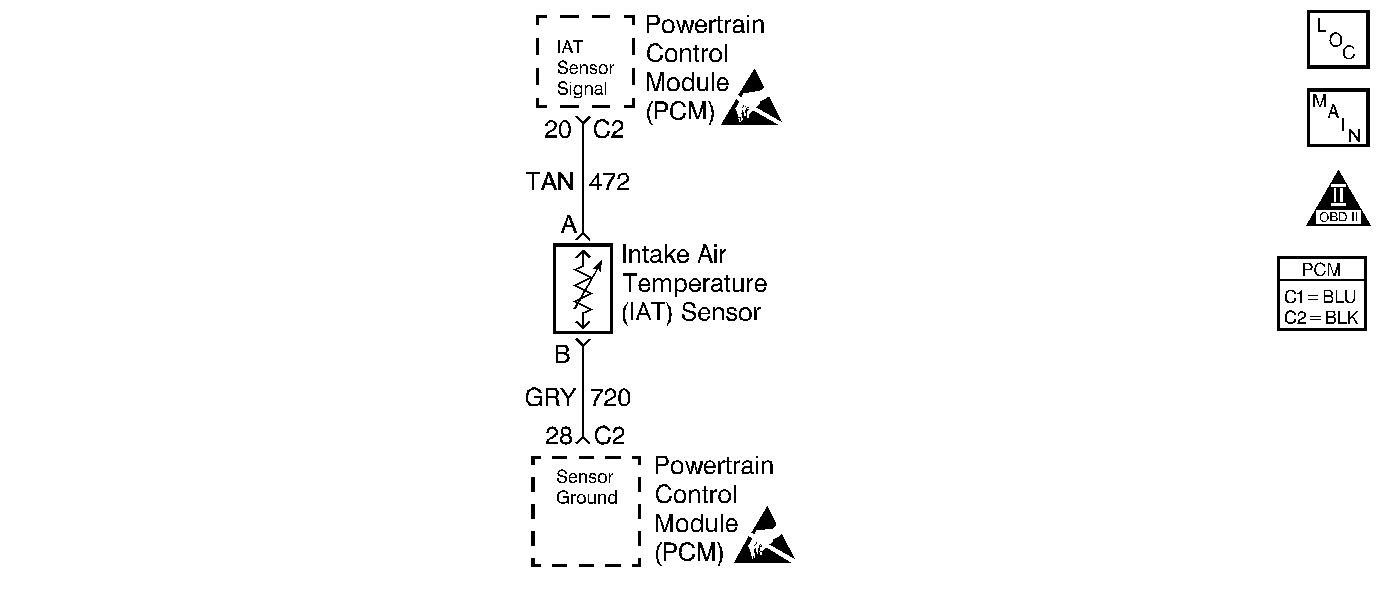
Circuit Description
The intake air temperature (IAT) sensor is a thermistor which controls the signal voltage to the powertrain control module (PCM). The PCM supplies a 5 volt reference and a ground to the sensor. When the air is cold, the resistance will be high. Whenever the intake air is warm, the resistance will be low.
Conditions for Running the DTC
| • | No active ECT DTCs |
| • | No active VSS DTCs |
| • | The engine run time is more than 320 seconds. |
| • | The engine coolant temperature (ECT) is more than -40°C (-40°F). |
| • | The vehicle speed sensor indicates that vehicle speed is less than 15 mph (24 km/h). |
Conditions for Setting the DTC
The IAT sensor signal voltage indicates that the intake air temperature is less than -40°C (-40°F) for 3 seconds.
Action Taken When the DTC Sets
| • | The control module illuminates the malfunction indicator lamp (MIL) if a failure is detected during 2 consecutive key cycles. |
| • | The control module sets the DTC and records the operating conditions at the time the diagnostic failed. The failure information is stored in the scan tools Freeze Frame and Failure Records. |
Conditions for Clearing the MIL/DTC
| • | The control module turns OFF the MIL after 3 consecutive drive trips when the test has Run and Passed |
| • | A history DTC will clear if no fault conditions have been detected for 40 warm-up cycles. A warm up cycle occurs when the coolant temperature has risen 22°C (40°F) from the startup coolant temperature and the engine coolant reaches a temperature that is more than 70°C (158°F) during the same ignition cycle. |
| • | Use a scan tool to clear the DTCs. |
Diagnostic Aids
| • | When the vehicle is at ambient temperature, compare the IAT sensor to the ECT sensor. The IAT sensor and the ECT sensor should be relatively close to each other. |
| • | Use the Temperature vs Resistance values table to evaluate the possibility of a skewed sensor. Refer to Temperature Versus Resistance . |
Test Description
The numbers below refer to the step numbers on the diagnostic table.
Important: Use the same diagnostic test equipment for all the measurements.
-
If the intake air temperature (IAT) sensor circuit voltage measures more than 4.9 volts, the conditions for the DTC are still present, and the problem is not intermittent.
-
This test will bypass the IAT sensor and will confirm that the IAT signal circuit and the sensor ground circuit to the PCM are sound. Grounding the IAT sensor signal circuit will provide a low voltage input to the PCM. The PCM should recognize this low voltage and indicate a high IAT temperature.
-
This test determines if the IAT sensor signal circuit is okay. If the scan tool does not indicate a high IAT temperature, the IAT signal circuit is open.
Step | Action | Value(s) | Yes | No |
|---|---|---|---|---|
1 | Did you perform the Powertrain On-Board Diagnostic (OBD) System Check? | -- | ||
Is the IAT sensor temperature less than the specified value? | -30°C (-22°F) | |||
Does the scan tool display an IAT sensor temperature more than the specified value? | 130°C (266°F) | |||
Jumper the IAT sensor signal circuit to a ground. Does the scan tool display an IAT sensor temperature more than the specified value? | 130°C (266°F) | |||
5 |
Is the voltage on the DMM more than the specified value? | 0.0 V | ||
6 | The DTC is intermittent. Are any additional DTCs stored? | -- | Go to Diagnostic Aids | |
7 | Check the IAT sensor harness connector and the PCM connector for a faulty connection. Refer to Connector Repairs . Did you find a problem? | -- | ||
8 | Check the IAT sensor ground circuit for an open or faulty connection between the IAT sensor and the PCM. Refer to Connector Repairs . Did you find a problem? | -- | ||
9 | Check the IAT sensor signal circuit for an open or faulty connection between the IAT sensor and the PCM. Refer to Connector Repairs . Did you find a problem? | -- | ||
10 | Repair the short to voltage in the IAT sensor signal circuit. Refer to Wiring Repairs in Wiring Systems. Did you complete the repair? | -- | -- | |
11 | Repair the circuit as necessary. Refer to Wiring Repairs or Connector Repairs in Wiring Systems. Did you complete the repair? | -- | -- | |
12 | Replace the IAT sensor. Refer to Intake Air Temperature Sensor Replacement . Did you complete the repair? | -- | -- | |
13 |
Important:: The replacement PCM must be programmed. Replace the PCM. Refer to Powertrain Control Module Replacement/Programming . Did you complete the replacement? | -- | -- | |
14 |
Does the scan tool indicate the diagnostic Passed? | -- | ||
15 | Does the scan tool display any additional undiagnosed DTCs? | -- | System OK |
